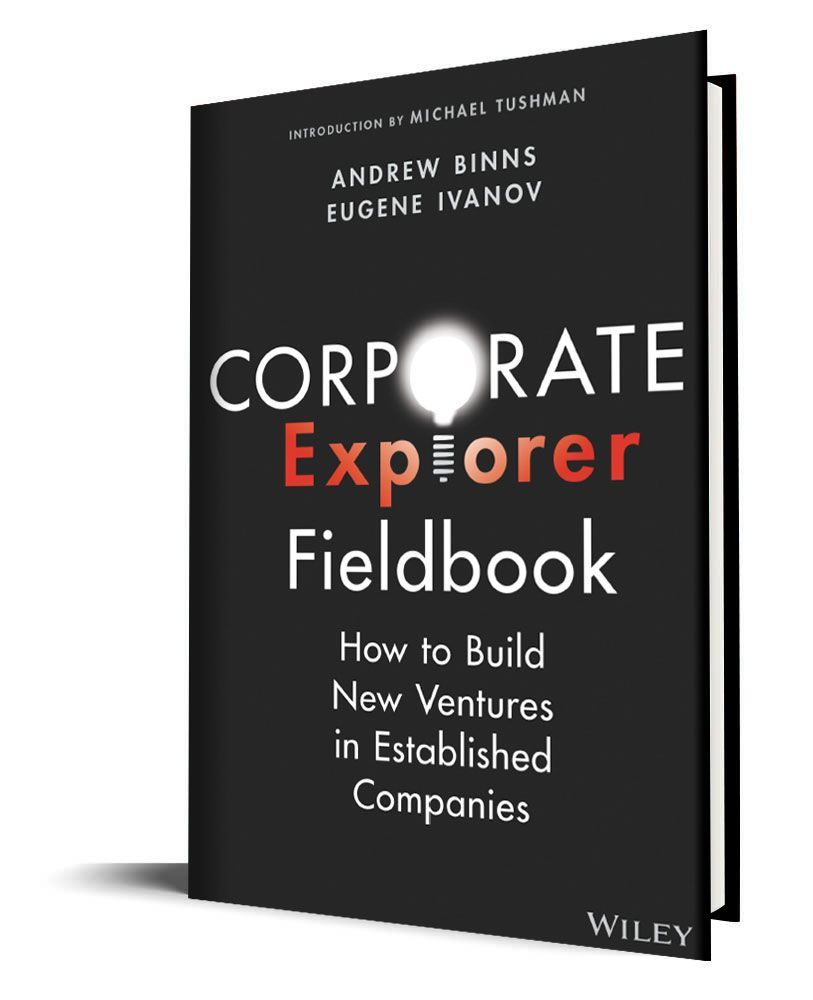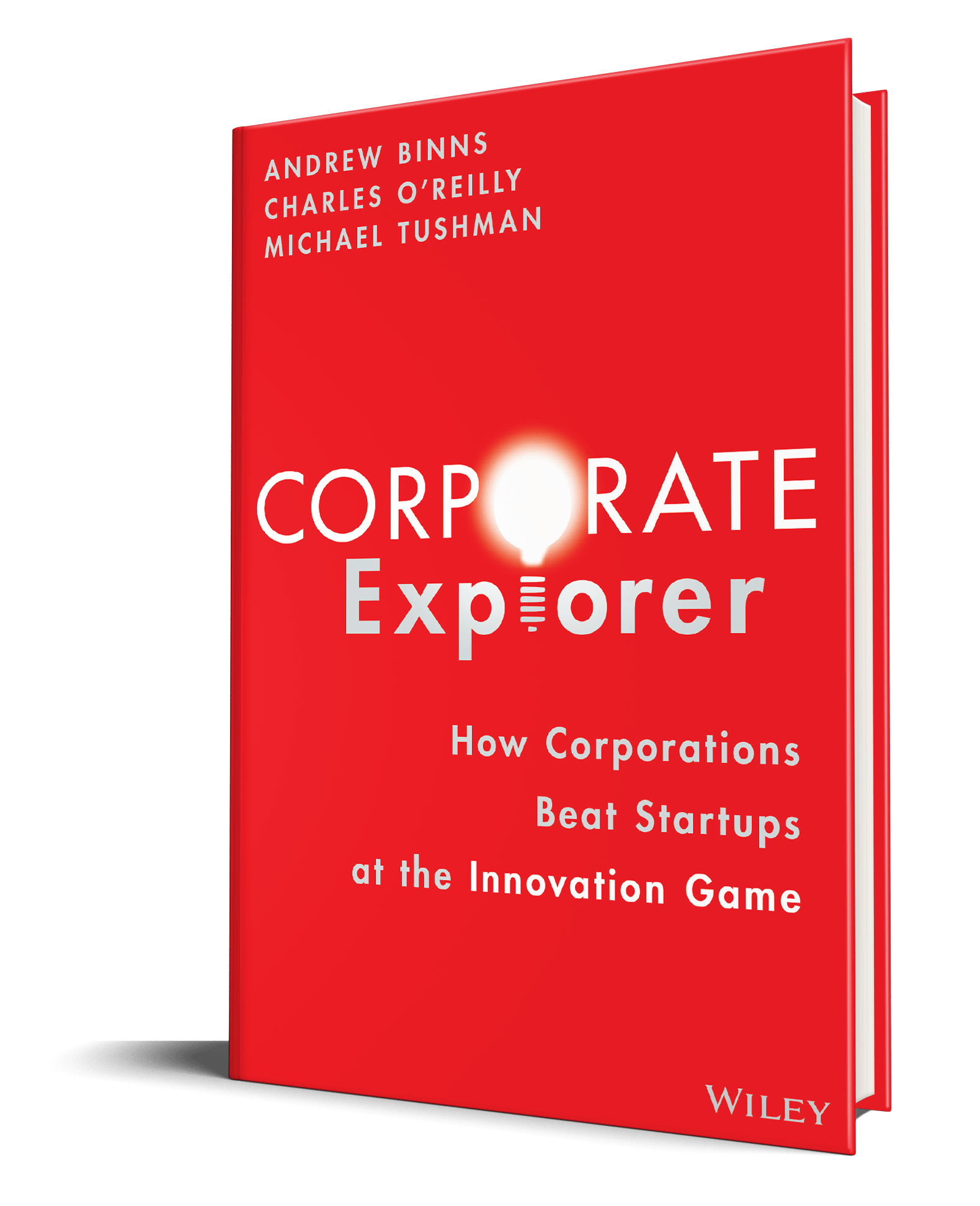Corporate Explorers are the new heroes of the corporate world who turn disruption into opportunity
Corporations have the upper hand over the startups that threaten to
disrupt them. They have the ideas, resources, and—critically—the talent to build new ventures from within. Smart companies—like Amazon, Microsoft, Bosch, and Analog Devices—make these assets count with secret weapons: Corporate Explorers.
These are managers that have the insight, resilience, and discipline to develop revenue-generating channels inside existing organizations. They are part entrepreneur, capable of using innovation disciplines to jump start cutting-edge ideas, and part change leader, able to create a movement within the organization
to support investment.
Inside the Fieldbook
A hands-on, how-to manual for innovating from within a corporation
In the Corporate Explorer Fieldbook: A Practitioner's Guide to Building New Ventures in Existing Organizations, a team of renowned innovation and change experts delivers an indispensable companion to the newly published Corporate Explorer: How Corporations Beat Startups at the Innovation Game. In the book, you'll find the tools, methodologies, and techniques you need to convert a great idea into a thriving, profitable business.
Explore the pain points, pitfalls, and opportunities experienced by real organizational leaders who adopted the Corporate Explorer framework and realized substantial successes. The book also offers:
- Strategies for bridging the gap between a good idea and an innovative, new business reality
- Ways to go beyond well-known methodologies, like Lean Startup and Design Thinking, and implement practical techniques
- Intuitive combinations of innovation, strategy, change, and leadership advice you can apply immediately to create exciting new business opportunities
An essential and hands-on guide for corporate innovators working within the confines of existing organizations, the Corporate Explorer Fieldbook is a must-read for managers, executives, team leaders, and corporate entrepreneurs seeking to have an outsized impact on their companies.
Chapter Overviews
19 Chapters by leading practitioners, academics, and advisers
- Strategy Manifesto: Answering the Big “Why”
Strategy manifestos give license to Corporate Explorers to innovate and build new ventures. This chapter tells you how to write one and uses the example from UNIQA Insurance Group in Austria.
—Andrew Binns and Andreas Brandstetter - Hunting Zones: Selecting Where to Explore
Hunting Zones is a method for defining where to find the most attractive opportunities for Corporate Explorers. This chapters explains how to apply it and uses the Japanese firm, AGC, as an example.
—Andrew Binns - Outside-In: Overcoming Toxic Assumptions with Market Insight
Seeing market opportunities clearly means challenging assumptions of the existing business that can be toxic to exploring into new areas. Learn how Cigna Insurance Europe avoided this trap.
—Narendra Laljani
- Jobs-to-be-Done: Defining a Market by Customer Outcome
Corporate Explorers do not create markets, they create products to deliver outcomes that customers want. This is a vital pre-step to developing a value proposition. This chapter introduces a new market definition canvas to use.
—Tony Ulwick
- From Explorer’s Insight to Opportunity Story
It is a competitive marketplace inside corporations for resources and funding. Corporate Explorers need a compelling story that fires the imagination of potential sponsors. This chapter describes two tools for going from insight to opportunity.
—George Glackin
- Ideation from Within: How to Generate Breakthrough Ideas from Within Large Corporations
Employees are a great resource of innovation. The IDEAS Framework is a method for using them to generate ideas. In a practical step by step approach, this chapter gives explorers a new tool and describes its application.
—Kaihan Krippendorff - Ideation from Outside:A Step-by-Step Guide to Challenge-Driven Innovation
Tapping external crowds is a powerful way to solve technical, product, and business model challenges. The UK Ministry of Defense have made good use of this to spur innovation.
—Bea Schofield and Simon Hill - Business Model Maturity: Using Customer Evidence to Validate New Ventures
Corporate ventures often advance without a proper assessment of the maturity of their business model. This chapter presents a methodology for ensuring that the business model risks receive equal attention to the technical ones.
—Michael Nichols and Uwe Kirschner - Get Out of the Building: How to Gather Customer Discovery Data
Customer discovery is a disciplined way to uncover insights about the problems an explorer aims to solve. Using a project at Bosch as an example, this chapter explains how to do this.
—Vanessa Ceia and Sara Carvalho - Value Propositions: Using Value Flows and Design Criteria Maps
Use a method for designing a value proposition so that it generates customer delight and differentiates you from alternatives. P&G’s Swiffer did this and so created a new multi-billion-dollar franchise.
—George Glackin - Business Experiments: De-risking Execution Spend
Information reduces the uncertainty of investing in a new value proposition. Here is how you gather it in a structured way to de-risk investments. The chapter uses the example of General Motors in China to explain how to do this work.
—Sarah Spoto and Vincent Ducret - Ecosystems: Building an Ecosystem Playbook for Scaling
New value propositions scale when a community of partners, distributors, and influencers align. This chapter explains how to do this, using a case from the semiconductor industry.
—Christine Griffin and John Greco - Validation: Managing the Journey from Concept to Scale
Scaling a new concept requires clarity on what sort of business you are building and what sort of action is needed for it to be successful. The chapter shares lessons from building new ventures at Mann+Hummel
—Ellie Amirnasr and Charles Vaillant - Ambidextrous Organization: What It Is, When to Use It
Corporate Explorers need a separate organizational unit if they are to succeed at breakthrough innovation. This chapter explains what is required and uses the case of AGC to describe how it is done.
—Michael Tushman and Charles O’Reilly - Explore Unit: How to Build a Team for Exploration
Companies that want many Corporate Explorers often set up an exploring unit. This chapter uses the example of the formation of SanusX by the Vienna-based insurance company UNIQA as a template for creating a new unit.
—Christine Griffin, Erich Kruschitz, and Andrew Binns - Strategic Diversity: Selecting and Developing Corporate Exploration Teams
The founding team of a new venture needs many different personalities and working styles. This chapter explains how you can match your team to the needs of the business.
—Richard Robertson - Leading High-Stakes Conversations: Getting the Senior Team Onboard
Corporate Explorers are often outliers who need to get call attention to uncomfortable truths in the organization. This chapter explains how to raise the tension, but keep the conversation productive.
—Alexander Pett and Kristin von Donop - Leadership Movement: Enrolling Others in the Work of Transformation
Corporate Explorers succeed when they have a network of supporters assisting and advocating for their business. At Intel Israel, they turned this into a movement, generating extraordinary outcomes for the business.
—Kristin von Donop and Yaniv Garty - Organizational Culture: The Silent Killer of Exploration
Culture is the most often cited inhibitor to successful corporate innovation, but it can be changed. Here is how they did it at Microsoft.
—Charles A. O’Reilly III

Corporate Explorers help drive innovation by bringing new ideas into organizations, securing the backing to deliver and ultimately build or expand new businesses. The Corporate Explorer Fieldbook is an indispensable guide for anyone who aspires to play this role. It is a hands-on guide written by practitioners, for practitioners. The authors have the scars to prove that they have done the things that they are writing about."
—
Dan Olley,
Chief Executive Officer, Hargreaves Lansdown

The value of the Corporate Explorer Fieldbook is in the practical detail and application case studies. This allows me to see what the leaders were aiming to do and how they used these specific levers to execute change. It helps to learn from real world examples and not just theoretical concepts.”
—
Dr. Alexander Bockelmann,
Group Chief Technology Officer, Baloise Group

Corporate Explorers combines hard-won knowledge from seasoned practitioners with deep research insights, to create the perfect travel companion for any corporate innovation journey.”
—
Gaby Appleton,
Chief Digital Product Officer, RX Global
“Corporate Explorer is a practical guide to building new businesses in large, complex organizations and provides a state-of-the-art framework for innovation. Binns, O’Reilly and Tushman have expertly described what makes the difference between success and failure in these efforts.”
— Dr. Uwe Kirschner, Partner, Bosch Management Consulting
Inside the book
Corporate Explorer
is a guidebook to the practices that enable these managers to go from idea into action. It explains how success as a Corporate Explorer is not only possible, but just as feasible
as a venture-capital backed entrepreneur.
- Create a career path as an innovator from within a corporation
- Learn how to apply innovation practices with greater discipline
- Turn great ideas into a full-time job as an innovation leader
- Change disruption from threat to opportunity
- Experiment with and scale original business models
- Transform innovation programs into a thriving source of new business
- Attract, retain, and motivate entrepreneurial talent
- Energize employees by creating a realistic way to innovate
These lessons come from the trailblazers of corporate innovation—Andrew Binns (Change Logic), Charles O'Reilly (Stanford Graduate School of Business), and Michael Tushman (Harvard Business School)—who have decades of experience helping entrepreneurial-minded executives activate employees to become Corporate Explorers.
Get The Corporate Explorer Today

If you think you can’t change a big company from the inside, The Corporate Explorer will prove you wrong. This book is a practical guide to what every aspiring innovator needs to know."
—
Gavin Patterson,
President and Chief Revenue Officer, Salesforce.com

As a Corporate Explorer myself, this book is a bible that provides insights and practical guidelines for being a disruptor that can bring about real change and success.”
—
Yoky Matsuoka,
Founder and CEO of Yohana,
Managing Executive Officer of Panasonic

It is a must read for any business professional who accepts that unless they embrace an ever-changing world, they will become victims of this change rather than victors. Peppered with dozens of examples from the real world, this is a book of great insight and clarity that demonstrates the vast experience [the authors] have gathered over the years.
—
Tomer Zvulun,
General & Artistic Director, The Atlanta Opera

Getting a group of passionate people completely focused on realizing a vision that excites them is how startups win over bigger companies. Focusing, executing, and investing in culture—because you can copy anything but a company’s culture. The realism in the approach in this book is key. If you think it's about process and methodology you're wrong. It's about people, culture, behavior.
—
Adam Singolda,
Founder & CEO Taboola.com Ltd, Co-founder of K Health





